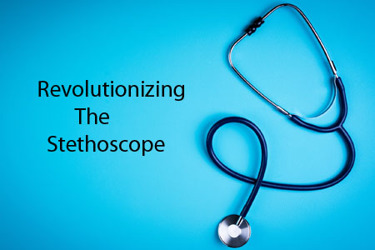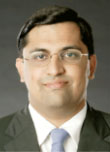How One Company Developed The Next-Generation Electronic Stethoscope
By Arvind Thiagarajan, founder and CEO of HD Medical, Inc.

Innovations in medicine inspire continued progress to address both changing needs and developing technology. The stethoscope has been a staple for healthcare providers since the early 1800s, but that simple monaural earpiece has evolved to the ubiquitous binaural stethoscope with a single bell, then to the electronic stethoscope. These innovations addressed amplifying heart and lung sounds, dampening external noise, and storing data electronically. Through all the physical and technological improvements, the basic stethoscope premise has served its purpose for more than a century, in part because innovators didn’t settle for the way it was always done. Instead, visionaries continue to find ways to improve the healthcare landscape.
A pressing issue driving improvement in stethoscope technology is the change in modern-day healthcare, which includes an increase in cardiovascular disease and the proclivity to diagnose early to prevent morbidity. The quick jump to use technology to diagnose heart disease has led to a decrease in auscultation expertise among healthcare professionals. There’s a greater need to provide a diagnostic tool that goes beyond amplified sound with the ability to change the way medicine is practiced.
Almost 18 million people die from cardiovascular disease (CVD) each year, with 2,000 Americans dying every day. In many cases, there’s a lag between when a patient exhibits symptoms and gets diagnosed. It’s a classic problem of patients experiencing symptoms away from their physicians, then often being unable to schedule a specialist consultation and then obtaining the proper imaging modality within a reasonable time. That waiting time can be a risky period.
Building A Better Stethoscope
For physicians to effectively triage and perform objective screenings at the point of care, they need more efficient tools. Next-generation technology offers AI-enabled intelligence, a phonocardiogram, and an electrocardiogram in one stethoscope device.
By amplifying sound, suppressing ambient noise with sensors and hardware, and adding AI, an intelligent stethoscope with integrated ECG allows the user to visualize the sounds instead of relying on auscultation. Healthcare providers can objectively view low-frequency sounds as a waveform. Using a smartphone app, physicians can capture, record, replay and see heart sounds and ECG waveforms simultaneously in different colors. The simple “see what you hear and what you don’t hear” interface offers instant insight into murmurs or any other abnormal heart sounds.
There are several electronic stethoscopes available, but healthcare providers need more than a glorified amplifier. They need an intelligent stethoscope with digital signal processing (DSP) technology that can prescreen for structural and mechanical conditions of the heart and pre-triage for electrical and ischemic cardiac conditions. Interfacing with a mobile app and the ability to record and share information from a cloud-based platform will provide a full-spectrum package, making it a viable telemedicine tool. Nurses, general practitioners, caregivers, physician assistants, and others need to be empowered to view the relevant information easily and act accordingly. HD Steth satisfies these criteria and is currently part of a pilot program in Asia supported by HD Medical.
Developing A Functional Product To Meet Clinician Needs
To create a product that best serves the needs of physicians, it is imperative for physicians to be part of the development process. Our development was largely driven by many physicians, including world renowned cardiologist Nelson Schiller, MD, professor of medicine & anesthesia, University of California, San Francisco, and Shaun Setty, MD, a cardiothoracic surgeon in Los Angeles. In addition to Dr. Schiller and Dr. Setty, many other leading doctors and cardiologists provided real-time feedback regarding both the physical design and the technology of the product.
An early version of HD Steth created and released in Asia almost a decade ago included a visual display integrated into the stethoscope. Physicians appreciated the access to information, but the device was simply too bulky, especially when most doctors had smartphones. Clinicians requested Bluetooth technology, which is more secure and convenient. Doctors were instrumental in defining our features and specifications from the onset of our process through the ongoing review of our progress toward meeting their wish list of features to better help their patients. This input affected everything from the length of the tubes, weight, whether it should pair with a tablet or a phone, and simplicity of use.
Physicians using the final product can see high-fidelity sounds displayed in real time. That information can be saved and shared for diagnosis and consultation. Bi-directional communication between the HD Steth and the app enables doctors to easily collaborate with remote specialists. It also allows the storage and comparison of data along a timeline that can further identify treatment points. Even with all of these technological improvements the device still feels like a stethoscope, which is integral to its success.
For best practices for implementation and physician adoption, it has to function as a regular stethoscope in addition to providing the ability to visualize heart sounds and high-frequency waveforms. Attaining U.S. Food & Drug Administration (FDA) clearance and ensuring physicians can leverage the tool as part of an existing clinical workflow will facilitate adoption of the full concept. Training has to be simple and straightforward so mid-level practitioners can work with the device easily without the need for extensive specialist training in echocardiogram interpretation.
For patients, there’s no wait to schedule an ECG and get results. There’s instantaneous evidence-based detection at the point of care. The form factor is familiar; they are used to being examined with a stethoscope, so there’s no added anxiety.
Accelerating The Future
The stethoscope with ECG, combined with other vital parameters such as heart rate, temperature, pulse oximetry (SpO2), respiration rate, and blood pressure trend, integrated into a compact and user-friendly device, could change the way remote patient monitoring and tele-health are delivered to patients at home.
About The Author:
 Arvind Thiagarajan is the founder and CEO of HD Medical. When he was at school, he had a mitral valve prolapse and underwent ultrasound echocardiograms every six months to determine whether he needed surgery, which inspired his life’s work. The HD Medical ViScope Visual Stethoscope was used to screen 30,000 children as part of National Rural Health Mission (NRHM) initiative in Kerala State in India to detect cardiac murmurs and defects. His second invention, a data compression technology called ABO (Adaptive Binary Optimization) at MatrixView was chosen as one of the Top 5 evolving technologies by CNBC Asia and twice named the Frost & Sullivan Best Technology Award for medical imaging. Hundreds of hospitals worldwide use MatrixView’s technology for solving storage and transmission issues. Thiagarajan continuously kick-starts innovations such as HealthyU, which takes point of care to the consumer.
Arvind Thiagarajan is the founder and CEO of HD Medical. When he was at school, he had a mitral valve prolapse and underwent ultrasound echocardiograms every six months to determine whether he needed surgery, which inspired his life’s work. The HD Medical ViScope Visual Stethoscope was used to screen 30,000 children as part of National Rural Health Mission (NRHM) initiative in Kerala State in India to detect cardiac murmurs and defects. His second invention, a data compression technology called ABO (Adaptive Binary Optimization) at MatrixView was chosen as one of the Top 5 evolving technologies by CNBC Asia and twice named the Frost & Sullivan Best Technology Award for medical imaging. Hundreds of hospitals worldwide use MatrixView’s technology for solving storage and transmission issues. Thiagarajan continuously kick-starts innovations such as HealthyU, which takes point of care to the consumer.
